

The Great Pacific Garbage Patch: "Out of Sight, Out of Mind" Image courtesy of GreenpeaceDeep Sea News' Kevin Zilnio points us to a great piece in The Independent describing what has become known as the "Great Pacific Garbage Patch," or "trash vortex" - essentially a floating expanse of waste and debris in the Pacific Ocean now covering an area twice the size of the continental U.S.

Believed to hold almost 100m tons of flotsam, this vast "plastic soup" stretches 500 nautical miles off the Californian coast, past Hawaii and almost as far as Japan: "The "soup" is actually two linked areas, either side of the islands of Hawaii, known as the Western and Eastern Pacific Garbage Patches. About one-fifth of the junk – which includes everything from footballs and kayaks to Lego blocks and carrier bags – is thrown off ships or oil platforms. Researchers Explore Growing Ocean Garbage Patches. Marine Debris Program - Marine Debris Info. The name “Pacific Garbage Patch” has led many to believe that this area is a large and continuous patch of easily visible marine debris items such as bottles and other litter —akin to a literal island of trash that should be visible with satellite or aerial photographs.
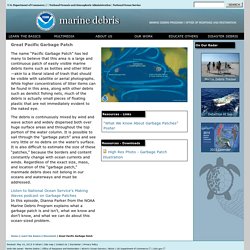
While higher concentrations of litter items can be found in this area, along with other debris such as derelict fishing nets, much of the debris is actually small pieces of floating plastic that are not immediately evident to the naked eye. La-me-ocean2aug02,0,4917201. The albatross chick jumped to its feet, eyes alert and focused.
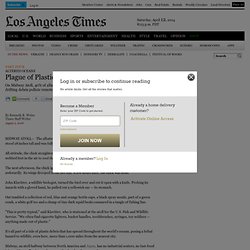
At 5 months, it stood 18 inches tall and was fully feathered except for the fuzz that fringed its head. All attitude, the chick straightened up and clacked its beak at a visitor, then rocked back and dangled webbed feet in the air to cool them in the afternoon breeze. The next afternoon, the chick ignored passersby. The bird was flopped on its belly, its legs splayed awkwardly.
Its wings drooped in the hot sun. John Klavitter, a wildlife biologist, turned the bird over and cut it open with a knife. Out tumbled a collection of red, blue and orange bottle caps, a black spray nozzle, part of a green comb, a white golf tee and a clump of tiny dark squid beaks ensnared in a tangle of fishing line. "This is pretty typical," said Klavitter, who is stationed at the atoll for the U.S. As they scour the ocean surface for this sustenance, albatross encounter vast expanses of floating junk. Scientists Find "Great Pacific Ocean Garbage Patch" Press Release 09-159 Scientists Find "Great Pacific Ocean Garbage Patch" Discover extensive plastic debris floating 1,000 miles from land August 27, 2009.
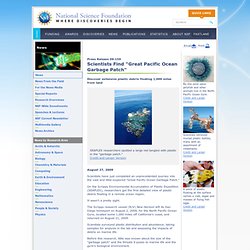
Ocean Conservancy's International Coastal Cleanup Meets North Pacific Gyre, or Eastern Pacific Garbage Patch. People know that trash in the water: compromises the health of humans, wildlife and the livelihoods that depend on a healthy ocean;threatens tourism and recreation, and the critical dollars they add to our local economies;complicates shipping and transportation by causing navigation hazards; andgenerates steep bills for retrieval and removal.
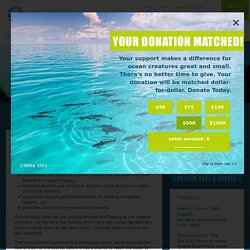
Unfortunately, what we see dirtying beaches and floating on the ocean’s surface is just the tip of the iceberg. Much more lies unseen beneath the surface and far away on the open water — but that doesn’t make it any less important. That’s why Ocean Conservancy is taking bold action, working to stop the flow of trash at the source, before it has a chance to reach the water to choke and entangle dolphins or endanger sea turtles, or ruin our beaches and depress our local economies. We need your help to keep millions of pounds of trash from our oceans - your everyday choices can help keep it clean. A Movement for Trash Free Seas. Pacific Ocean trash patch mystery: How many fish eat plastic? Small fish living in a region of the Pacific Ocean where floating trash collects in a huge, slowly swirling bowl eat as much as 24,000 tons of plastic waste each year, scientists have found.

Skip to next paragraph Subscribe Today to the Monitor Click Here for your FREE 30 DAYS ofThe Christian Science MonitorWeekly Digital Edition. 'Great Garbage Patch' in the Pacific Ocean not so great claim scientists. Prof White said: "There is no doubt that the amount of plastic in the world's oceans is troubling, but this kind of exaggeration undermines the credibility of scientists.

"We have data that allow us to make reasonable estimates. We don't need the hyperbole. "Given the observed concentration of plastic in the North Pacific, it is simply inaccurate to state that plastic outweighs plankton, or that we have observed an exponential increase in plastic. " Ocean gyre. An ocean gyre is a circular ocean current formed by the Earth’s wind patterns and the forces created by the rotation of the planet.
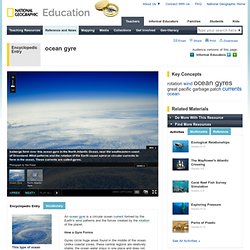
How a Gyre Forms Gyres circle huge areas found in the middle of the ocean. Unlike coastal zones, these central regions are relatively stable; the ocean water stays in one place and does not circulate.